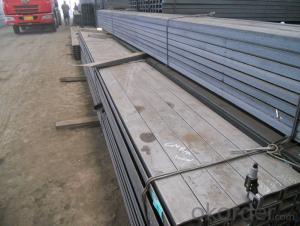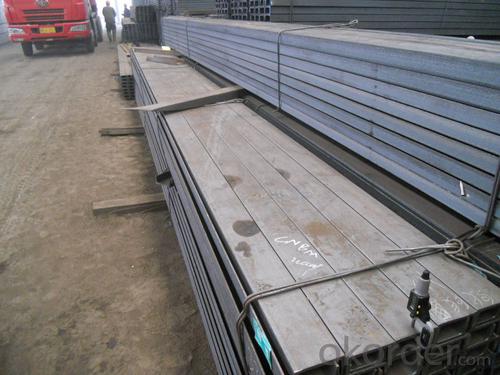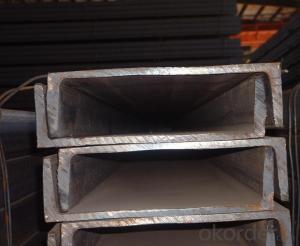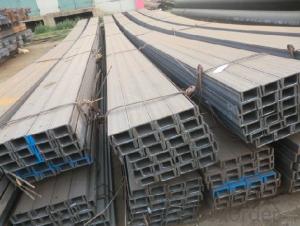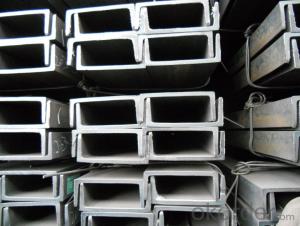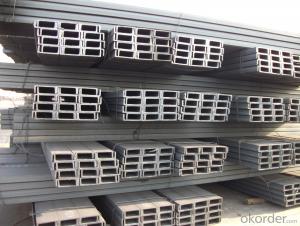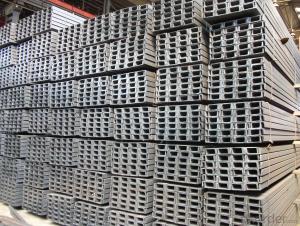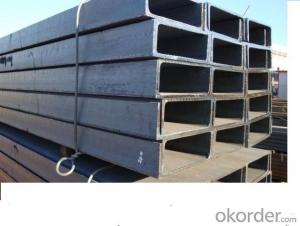High Quality 22# Steel Channel
- Loading Port:
- China Main Port
- Payment Terms:
- TT OR LC
- Min Order Qty:
- -
- Supply Capability:
- -
OKorder Service Pledge
OKorder Financial Service
You Might Also Like
Steel Channel
Standard: GB
Material: Q235
Length: 6m, 12m
Size:
| Size (mm) | Mass (Kg/m) |
| 220*77*7.0 | 24.999 |
| 220*79*9.0 | 28.453 |
The chemical composition of HR Channel Steel according to Q235B is shown in Table-1.
Alloy No | Grade | Element(%) | ||||
C | Mn | S | P | Si | ||
Q235 | B | 0.12-0.20 | 0.3-0.7 | ≦0.045 | ≦0.045 | ≦0.3 |
Table-1
Note: we are able to present our customers relevant SGS test report for chemical composition of HR Channel Steel.
The mechanical property of HR Channel Steel according to Q235B is shown in Table-2
Alloy No | Grade | Yielding Strength Point(Mpa) | |||
Thickness(mm) | |||||
≦16 | >16-40 | >40-60 | >60-100 | ||
≧ | |||||
Q235 | B | 235 | 225 | 215 | 205 |
Table-2
Package & Delivery of Channel:
1.The hot rolled channel steel will be packed in bundle with steel wire at each end of every bundle and color marking in order to help the customer to recognize his goods more easily at sight.
2. And the hot rolled channel steel could be loaded into 20ft or 40ft container, or by bulk cargo.If the weight of each bundle reaches more than 3.5 mt, the loading by break bulk cargo should be choosed.When the weight of each bundle reaches less than 3mt, the loading by container should be choosed.
3.As for the transportaion from mill to loading port, the truck will be usually used. And the maximum quantity for each truck is 40mt.
4.All in all, we could do in accordance with customer's request.
*If you would like to get our price, please inform us the size, standard/material and quantity. Thank you very much for your attention.
- Q: Can steel channels be used in the renewable energy sector?
- Certainly, the renewable energy sector can make excellent use of steel channels. These versatile structural components are widely employed and valued for their strength and durability. Within the renewable energy sector, there are various applications where steel channels can be utilized with great effectiveness. For instance, they can be employed in the construction of solar panel frames, wind turbine towers, and support structures for hydroelectric power plants. When it comes to solar energy, steel channels prove to be indispensable in the manufacturing of photovoltaic (PV) panel frames. These frames play a crucial role in providing structural support and ensuring the solar panels remain intact. Steel channels possess the necessary strength to withstand the weight of the panels, as well as external forces such as wind and snow loads. Similarly, in the wind energy sector, steel channels find extensive use in constructing wind turbine towers. These towers must possess strength and rigidity to endure the rotational forces generated by the blades, as well as the dynamic loads caused by wind. Steel channels offer the required structural support and can be easily fabricated into tower sections of varying heights. Additionally, steel channels are also highly suitable for the construction of support structures in hydroelectric power plants. These structures must be capable of withstanding the weight of turbines, generators, and other equipment, all while enduring the force exerted by flowing water. Given their high strength and load-bearing capacity, steel channels are exceptionally well-suited for such applications. To summarize, steel channels bring numerous advantages to the renewable energy sector, including strength, durability, and versatility. Their utilization contributes significantly to the development of robust and reliable renewable energy infrastructure.
- Q: How do steel channels contribute to the overall speed of construction?
- There are several ways in which steel channels contribute to the overall speed of construction. To begin with, steel channels are prefabricated components that can be easily manufactured off-site and transported to the construction site. This eliminates the need for on-site fabrication, resulting in a significant reduction in construction time. Furthermore, steel channels possess the qualities of being lightweight yet strong, which makes them easy to handle and install. As a result, construction workers can quickly and efficiently assemble these components, saving both time and labor costs. Additionally, steel channels can be easily connected using various fastening methods such as welding or bolting, further expediting the construction process. Moreover, steel channels offer great flexibility in terms of design and can be easily modified or adjusted during construction. This adaptability allows construction projects to be completed at a faster pace, as changes can be made to the structure without causing significant delays or disruptions. Lastly, steel channels provide structural support and can be utilized in a variety of applications, including framing, bracing, and supporting heavy loads. Due to their high strength-to-weight ratio, they ensure the stability and durability of the construction, enabling faster progress without compromising safety. In summary, the inclusion of steel channels in construction plays a crucial role in speeding up the project by reducing fabrication time, facilitating quick assembly, accommodating design modifications, and offering structural support.
- Q: What are the fire rating requirements for steel channel structures?
- The fire rating requirements for steel channel structures are dependent on a variety of factors, which include the building code, occupancy type, and the purpose of the structure. The overall aim is to ensure the safety of occupants and prevent fire from spreading. Fire ratings for steel channel structures are determined by building codes, which take into account the occupancy classification and the height of the structure. For instance, in the United States, the International Building Code (IBC) outlines specific fire resistance requirements for residential, commercial, and industrial buildings. The fire rating of a steel channel structure signifies the amount of time it can endure the effects of fire without compromising its structural integrity. This rating is typically expressed in minutes or hours. A higher fire rating indicates that the structure can withstand fire for a longer duration, allowing more time for evacuation and firefighting. There are various methods used to achieve the required fire rating. One common approach involves applying fire-resistant materials like fire-rated gypsum board or intumescent coatings to the steel channels. These materials provide insulation and shield the steel from the intense heat during a fire. Additionally, structural engineers may incorporate specific fire-resistant features into the design of steel channel structures, such as fireproofing coatings, fire barriers, or fire-resistant insulation. These measures help prevent the rapid spread of fire and minimize heat-related damage. To determine the specific fire rating requirements for steel channel structures in a particular jurisdiction, it is crucial to consult the local building code and engage the services of a qualified structural engineer. Adhering to these requirements ensures that the structure meets necessary safety standards and can effectively withstand fire incidents.
- Q: No. 20 I-beam span 3 meters, fixed on both sides, what is the maximum weight to bear? No. 10 channel steel, span 2.5 meters, the other ibid
- Channel steel is a kind of carbon structural steel used for construction and machinery. It is a complex section steel. Its cross section has a groove shape. Channel steel is mainly used in building structure, curtain wall engineering, mechanical equipment and vehicle manufacturing, etc.. In use, it requires better welding, riveting performance and comprehensive mechanical properties.
- Q: What are the different types of steel channel supports?
- There are several different types of steel channel supports that are commonly used in construction and engineering projects. These supports are designed to provide structural stability and support for various applications. Some of the different types of steel channel supports include: 1. C-Channel Supports: These supports are shaped like a letter "C" and provide excellent strength and rigidity. They are commonly used in industrial applications such as supporting heavy equipment and machinery. 2. U-Channel Supports: Similar to C-channel supports, U-channel supports are shaped like a letter "U". They are versatile and can be used in a variety of applications, including framing and bracing structures. 3. Back-to-Back Channel Supports: These supports consist of two parallel channels that are welded back-to-back. They offer increased strength and stability and are commonly used in applications that require additional load-bearing capacity. 4. Slotted Channel Supports: Slotted channel supports feature slots along the length of the channel, allowing for easy adjustment and flexibility. They are often used in applications where the position of the support needs to be adjustable. 5. Strut Channel Supports: Also known as strut or framing channel supports, these are designed with specially shaped channels that allow for easy attachment of fittings and accessories. They are commonly used in electrical and mechanical installations. 6. Adjustable Channel Supports: These supports feature telescoping or adjustable sections that allow for height and width adjustment. They are commonly used in applications where the support needs to be adaptable to changing requirements. 7. Stainless Steel Channel Supports: Stainless steel channel supports are made from corrosion-resistant stainless steel, making them ideal for applications in harsh or corrosive environments. These are just a few examples of the different types of steel channel supports available. Each type offers unique features and benefits, allowing for a wide range of applications in various industries. The choice of support will depend on the specific requirements of the project and the load-bearing capacity needed.
- Q: Are steel channels suitable for use in high-temperature environments?
- Steel channels can be used in high-temperature environments depending on the specific type of steel and the temperature range involved. Some steels, such as carbon steels, may experience a decrease in strength and ductility at high temperatures, which could make them unsuitable for certain applications. However, there are also heat-resistant steels, such as stainless steels or alloy steels, that are specifically designed to withstand high temperatures without significant loss of strength or deformation. These heat-resistant steels can maintain their mechanical properties even at elevated temperatures, making them suitable for use in high-temperature environments. It is important to consult with experts or refer to relevant standards and guidelines to determine the appropriate steel type and grade for a specific high-temperature application.
- Q: Can steel channels be used for sign supports?
- Yes, steel channels can be used for sign supports. Steel channels are often used in construction and engineering projects due to their strength and durability. They are commonly used in applications where a high load-bearing capacity is required, making them suitable for supporting signs. Steel channels can be easily fabricated and customized to meet specific requirements, and they offer excellent resistance to weathering and corrosion, ensuring the longevity of sign supports. Additionally, steel channels provide stability and rigidity, ensuring that signs remain securely in place even in harsh environmental conditions.
- Q: Are steel channels available in pre-galvanized finishes?
- Yes, steel channels are available in pre-galvanized finishes.
- Q: How do steel channels perform in terms of thermal insulation?
- Steel channels do not perform well in terms of thermal insulation. Steel is a good conductor of heat, so steel channels tend to transfer heat easily. Consequently, they are not effective in providing insulation against heat transfer.
- Q: How do steel channels perform under earthquake loads?
- Steel channels generally perform well under earthquake loads due to their high strength and ductility. The design of steel channels allows them to effectively resist the dynamic forces and vibrations caused by earthquakes. The combination of their shape and material properties enables steel channels to effectively distribute and dissipate the seismic energy, minimizing the potential for structural damage. The stiff and rigid nature of steel channels allows them to withstand lateral loads and resist bending, torsion, and shear forces induced by earthquakes. Moreover, steel channels can be further enhanced with various seismic design strategies, such as incorporating additional bracing and connections, to improve their performance under earthquake loads. These design enhancements can further increase the structural stability and resilience of steel channels during seismic events. Additionally, steel channels are commonly used in earthquake-resistant buildings and structures due to their versatility and adaptability. They can be easily modified and reinforced to meet specific seismic design requirements, ensuring the overall safety and reliability of the structure. However, it is important to note that the performance of steel channels under earthquake loads is also influenced by factors such as the size, quality, and installation of the channels. Proper design, construction, and maintenance practices are crucial to ensure the optimal performance of steel channels in seismic conditions. Consulting with structural engineers and following relevant building codes and regulations is essential to ensure the proper design and installation of steel channels in earthquake-prone areas.
Send your message to us
High Quality 22# Steel Channel
- Loading Port:
- China Main Port
- Payment Terms:
- TT OR LC
- Min Order Qty:
- -
- Supply Capability:
- -
OKorder Service Pledge
OKorder Financial Service
Similar products
Hot products
Hot Searches
Related keywords
